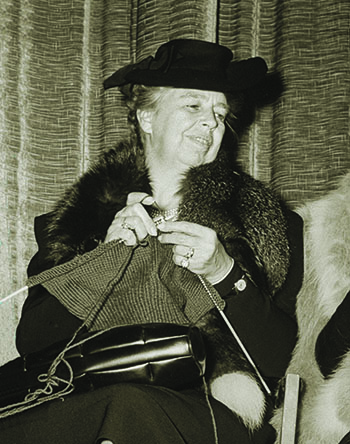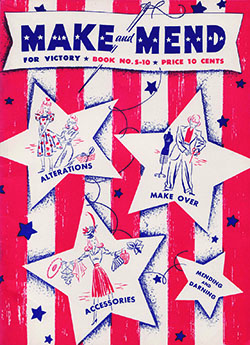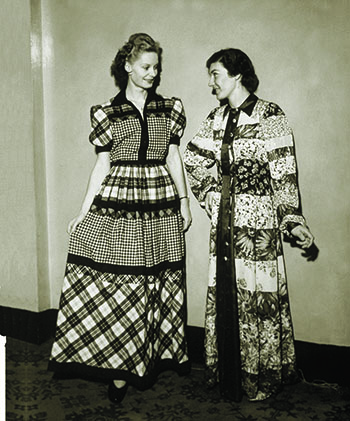[dropcap]A[/dropcap]s soon as the United States entered World War II, it became evident that the military’s materiel demands and the disruption of imports would cause serious shortages of civilian goods. How could the products that were available be distributed fairly? As was already the policy in Britain, the United States decided that strict rationing would be necessary for food, gasoline, and other items.
But for clothing, the U.S. government decided to take a gamble. Rather than set limits on purchases, it would rely on voluntary cooperation. (Shoes were the exception and became subject to rationing in February 1943 to accomodate the military’s high demand for leather and rubber.) While war would curtail textile imports—an important source of silk, cotton, and wool—and the military would create a huge demand for uniforms and other clothing materials, officials calculated that increased agricultural output and more efficient use of fabric could prevent serious shortages.
So Washington harnessed its propaganda resources to persuade everyone that clothing conservation was one way each citizen could contribute to victory. In posters, pamphlets, and speeches, they promoted it as a patriotic duty to keep using the old—and sew or knit your own—rather than stock up on new wardrobe items from the store. Many of the conservation tips impressed on Americans may now seem frivolous or funny, but to World War II officials, it was an extremely serious matter.
GOVERNMENT AGENCIES FED newspaper “women’s page” editors endless stories on how to repurpose clothing that seemed ready to be discarded. “If the housewife doesn’t know how to patch and darn, now is the time to learn,” insisted Louise Stanley, chief of the home economics bureau of the U.S. Department of Agriculture. “Resourceful women can save materials, labor and machines needed for war production.” Her department promoted slogans like “Patching is Patriotic” and “Darning May Save the Day.” First Lady Eleanor Roosevelt made sure that she was often photographed carrying a voluminous knitting bag—a practice that got her dubbed “First Knitter of the Land.”

But Washington also hedged its bets. While it did not place restrictions on clothing consumers, it put mandatory controls on manufacturers. The War Production Board (WPB) unveiled its approach at a February 17, 1942, meeting of some 800 fashion industry representatives at Manhattan’s Hotel Astor. The WPB’s clothing and textile program head, H. Stanley Marcus—on leave from his job as vice president of the family’s Neiman Marcus department store—told them that they had to find ways to make clothes “that use minimum rather than maximum yardage.” The board had decided it could not make industry compliance voluntary: what one company might consider a dispensable frill another company could use—placing the most compliant designs at a competitive disadvantage.
To “stretch today’s plenty into enough for tomorrow”—in Marcus’s words—the WPB set a goal a month after the Hotel Astor meeting of reducing civilian fabric use by 15 percent. Designs had to be within strict limits imposed by the board’s Order L-85, which forbade the use of wool lining, even if the wool was reprocessed. For men, it also meant the end of cuffs, wide lapels, double-breasted jackets, pocket flaps, and suits sold with two pairs of pants—until then the norm. For women, skirts had to be at least 17 inches above the floor and slacks had to have narrow legs. Hems and fabric belts could be no more than two inches wide, and no garment could have more than one pocket. The order banned pleats, ruffles, hoods, voluminous sleeves, and full skirts entirely.
The WPB excepted maternity clothes, bridal gowns, and religious vestments from the rule. Still, the lavish was out. Marcus warned that “any tendency toward longer or fuller skirts or extravagant use of materials would be about the worst fashion from an economic and patriotic point of view that any designer, magazines or store could foster.” The board encouraged designers to come up with creative solutions to the limitations and develop independent fashion signatures.
“This order has in no way hampered their freedom as far as originality is concerned,” Washington, DC, Evening Star fashion editor Helen Vogt wrote weeks after L-85 was promulgated. “In the past,” noted Marcus, “fashion has received its inspiration from the pages of history—the Renaissance, the Puritans, the French Empire. But today the inspiration must be the realistic modern one—war.”
Fashion industry journal Women’s Wear Daily called the clothing produced within these constraints “Victory fashions.”
INDIVIDUAL HOUSEHOLDS likewise had to embrace the mantra of doing with less. So while the government propaganda machine was preaching the need to sew and patch and redo, it also needed to persuade housewives that they didn’t have to sacrifice chicness for patriotic conservation.
Typical of the way that message was conveyed was the transformation of a weekly luncheon of the Woman’s National Democratic Club into a restyling fashion show. Among the “mannequins” at the May 1943 event in Washington, DC: Meredith Howard showed how to update a basic black dress with a frilly pink jabot; Mrs. F. Meade Fletcher demonstrated how a simple dress can be enhanced by adding vests, dickeys, or jabots; and Mrs. Allen Phelps used a number of apron-shaped pieces in such materials as white piqué and black lace to customize a hat so it could go with a number of outfits. Dora Loes Miller, fashion columnist for the Paris Herald-Tribune, admonished the women in the audience to be doubly patriotic: to not only reuse rather than purchase new, but to “buy a bond with what you save.”
The Office of Price Administration published a three-point “victory pledge” it asked housewives to abide by “in the total defense of democracy”: buy carefully, waste nothing, and take good care of everything. “Make and mend” was the byword. While during the lean Depression years families were ashamed to wear mended clothes, government propaganda now insisted that “A Patch is a Badge of Honor.” It encouraged housewives to appliqué over a hole and keep wearing that dress. The Works Project Administration designed posters urging women to “Sew for Victory.” And the Evening Star editorialized in early 1943: “Sewing is a patriotic as well as practical pastime these days, and wise women everywhere are learning to fashion clothes for the family as well as to remodel and repair old garments.”
Companies that could benefit from it were quick to endorse the tie between sewing at home and winning the war. The Spool Cotton Company (maker of thread sold under the J & P Coats brand name) ran ads urging: “Come on, take those old knockabouts and turn them into knockouts, keep the glint in Uncle Sam’s eyes and do your stint towards Victory!”

Mending and making became community projects, with help at hand. Just three months after the attack on Pearl Harbor, Pratt Institute—the Brooklyn university specializing in art and design—began three-times-a-week classes for city residents that taught them how to reuse clothing remnants; some 400 women enrolled in the first semester. At Reagan County High School in Big Lake, Texas, the head of the homemaking department ran a sewing center at the school each Tuesday where women could socialize, use the school’s sewing machines and pinking shears, consult style books, and get assistance in remodeling old clothes or making new ones. The Mothers’ Club of Calvert Hall, a Catholic boys’ high school in Baltimore, began a sewing class in March 1943 that met every Wednesday from 11 a.m. to 3 p.m., while the Tripp Home Demonstration Club in Mesquite, Texas, had day-long meetings devoted to “patching, mending, sewing on buttons.” The Red Cross opened sewing centers in office buildings across the country.
The idea was to get everyone involved. There was even a nationwide contest for the best garments made out of salvaged textiles—defined as remnants, mill ends, and clothing too worn to be otherwise usable. The top 25 entrants displayed their creations before what the contest literature called “a prominent Washington audience,” with the best of the best winning war savings bonds.
Youth organizations got girls sewing. Typical was the Williamson County 4-H Club in Texas, which for 1943 set a goal for each member to make a dress or coverall, a hat, and a housecoat. In the homemaking class at Little Valley High School in New York, each girl was expected to make one piece of clothing: dress, skirt, pajamas, or—for the less adept—an apron. One indicator of success: in the National Needlecraft Bureau’s annual National Sewing Contest for girls 17 and younger, the 1943 event drew 22 percent more entrants than the 1942 contest—and 33 percent more than in 1941. Another sign: a company selling dressmaking patterns spotlighted through King Features newspaper syndication reported booming sales, with 1944 figures running 50 percent above 1943’s.
IDEAS ABOUNDED for how home seamstresses could “give last year’s dress a new lease on life” with a crocheted belt, frilled edging on a collar, or colorful replacements from the button box. In a 10-cent, 50-page booklet of instructions for remaking old garments into something new, Spool Cotton argued that “there’s probably no satisfaction to equal the satisfaction of making something out of nothing. You can be pretty and patriotic, too.” Is the woolen material worn? Use the reverse side. The color no longer flattering? Dye it. Dress sleeves worn through at the elbows? Cut off the sleeves and underarm sections and produce a pinafore. Coat no longer usable? Salvage enough to make a skirt and matching bolero.
For seamstresses ready for a major challenge, the booklet promised “the tailored suit you’ve always had your heart set on is yours for the making out of a man’s suit—suits made of precious priority wools drooping forlorn and unworn on their hangers while their owners are away wearing Uncle Sam’s latest models.” The Baltimore Sun printed directions for such a project, including ripping each trouser leg in two to provide material for a four-panel skirt; for the coat, “simply cut the back down to your size after doubling it over.” The paper offered to send a pattern to those who wrote asking for one. Reporter Virginia Scholz not only tackled such a project, but she wrote about it in an article illustrated with her modeling the stylish result.

It wasn’t just about making do. The clothing conservation campaign urged that new purchases be made with an eye toward not aggravating shortages. For example, Pacific Factag Fabrics took out a full-page ad in the December 6, 1943, issue of Life magazine, directing those with a loved one in the services to “help him do his job, by faithfully performing your duties here at home.” The copy strongly advised: “The way is simple: buy only what you need, buy it wisely and care for it properly.”
The government pressured retailers to stop using phrases like “Buy Now” in their advertising. Among events advancing smart purchasing propaganda was a November 1942 fashion show in which New York University home economics students modeled coats—including a boxy gray Chesterfield and a blue tweed with a lining that zipped in or out—that could be used for both evening social events and daytime classes.
BY AND LARGE, the government’s gamble to rely on patriotism rather than rationing to curb civilian clothing use worked. The conservation campaign saved resources, got ordinary citizens involved in the war effort, and helped prevent melees when scarce merchandise showed up at department store loading docks. The social pressure to dress patriotically was so intense that many men kept their perfectly good prewar suits hanging in their closets because the pants had cuffs, a verboten frill under Order L-85.
There were limits to its success, though. While government guidelines urged women to go without gloves, at least in warm weather, many resisted, considering it unladylike. Even at the fashion show the Women’s National Democratic Club held to promote clothing economy, the models carried white gloves—some with linings matching their outfits. Wartime or not, a person could only go so far. ✯





